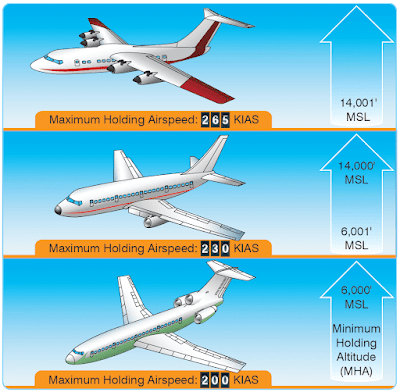The criteria for holding pattern airspace is developed both to provide separation of aircraft, as well as obstacle clearance. The alignment of holding patterns typically coincides with the flight course you fly after leaving the holding fix. For level holding, a minimum of 1,000 feet obstacle clearance is provided throughout the primary area. In the secondary area, 500 feet of obstacle clearance is provided at the inner edge, tapering to zero feet at the outer edge. Allowance for precipitous terrain is considered, and the altitudes selected for obstacle clearance may be rounded to the nearest 100 feet. When criteria for a climb in hold are applied, no obstacle penetrates the holding surface. [Figure 1]
 |
| Figure 1. Holding pattern design criteria template |
There are many factors that affect aircraft during holding maneuvers, including navigational aid ground and airborne tolerance, effect of wind, flight procedures, application of ATC, outbound leg length, maximum holding airspeeds, fix to NAVAID distance, DME slant range effect, holding airspace size, and altitude holding levels.
ATC Holding Instructions
When controllers anticipate a delay at a clearance limit or fix, pilots are usually issued a holding clearance at least five minutes before the ETA at the clearance limit or fix. If the holding pattern assigned by ATC is depicted on the appropriate aeronautical chart, pilots are expected to hold as charted. In the following example, the controller issues a holding clearance that includes the name of the fix, directs the pilot to hold as charted, and includes an expect further clearance (EFC) time. “Marathon five sixty four, hold east of MIKEY Intersection as published, expect further clearance at 1521.”
When ATC issues a clearance requiring you to hold at a fix where a holding pattern is not charted, pilots are issued complete holding instructions. The holding instructions include the direction from the fix, name of the fix, course, leg length, if appropriate, direction of turns (if left turns are required), and the EFC time. Pilots are required to maintain the last assigned altitude unless a new altitude is specifically included in the holding clearance and should fly right turns unless left turns are assigned. Note that all holding instructions should include an EFC time. In the event that two-way radio communication is lost, the EFC allows the pilot to depart the holding fix at a definite time. Pilots should plan the last lap of the holding pattern to leave the fix as close as possible to the exact time. [Figure 2]
 |
| Figure 2. ATC holding instructions |
When approaching the clearance limit and you have not received holding instructions from ATC, pilots are expected to follow certain procedures. First, call ATC and request further clearance before reaching the fix. If further clearance cannot be obtained, pilots are expected to hold at the fix in compliance with the charted holding pattern. If a holding pattern is not charted at the fix, pilots are expected to hold on the inbound course using right turns. This procedure ensures that ATC provides adequate separation. [Figure 3] For example, the aircraft is heading eastbound on V214 and the Cherrelyn VORTAC is the clearance limit and the pilot has not been able to obtain further clearance and has not received holding instructions, plan to hold southwest on the 221° radial using left-hand turns, as depicted. If this holding pattern is not charted, hold west of the VOR on V214 using right-hand turns.
 |
| Figure 3. Clearance limit holding |
Where required for aircraft separation, ATC may request that the pilot hold at any designated reporting point in a standard holding pattern at the MEA or the MRA, whichever altitude is the higher at locations where a minimum holding altitude has not been established. Unplanned holding at en route fixes may be expected on airway or route radials, bearings, or courses. If the fix is a facility, unplanned holding could be on any radial or bearing and there may be holding limitations required if standard holding cannot be accomplished at the MEA or MRA.
Maximum Holding Speed
The size of the holding pattern is directly proportional to the speed of the aircraft. In order to limit the amount of airspace that must be protected by ATC, maximum holding speeds in knots indicated airspeed (KIAS) have been designated for specific altitude ranges. [Figure 4] Even so, some holding patterns may have additional speed restrictions to keep faster aircraft from flying out of the protected area. If a holding pattern has a nonstandard speed restriction, it is depicted by an icon with the limiting airspeed. If the holding speed limit is less than the pilot feels necessary, advise ATC of the revised holding speed. Also, if the indicated airspeed exceeds the applicable maximum holding speed, ATC expects the pilot to slow to the speed limit within three minutes of the ETA at the holding fix. Often pilots can avoid flying a holding pattern, or reduce the length of time spent in the holding pattern, by slowing down on the way to the holding fix.
 |
| Figure 4. Maximum holding speeds for different altitudes |
High Performance Holding
When operating at higher airspeeds, there are certain limitations that must be adhered to. For example, aircraft do not make standard rate turns in holding patterns if the bank angle exceeds 30°. If your aircraft is using a flight director system, the bank angle is limited to 25°. The aircraft must be traveling over 210 knots true airspeed (TAS) for the bank angle in a standard rate turn to exceed 30°; therefore, this limit applies to relatively fast aircraft. An aircraft using a flight director would have to be holding at more than 170 knots TAS to come up against the 25° limit. These true airspeeds correspond to indicated airspeeds of about 183 and 156 knots, respectively, at 6,000 feet in a standard atmosphere.
